Pump Handbook by Igor J. Karassik, Joseph P. Messina, Paul Cooper, Charles C. Heald - 3rd edition
Подождите немного. Документ загружается.

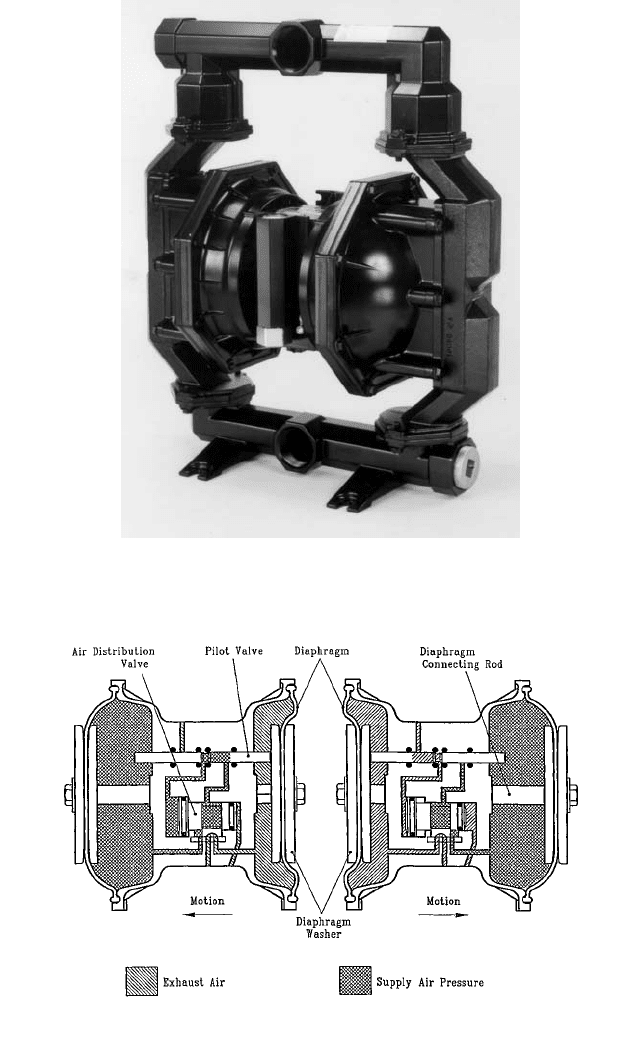
3.94 CHAPTER THREE
FIGURE 11 Cross-section of an air-operated double-diaphragm pump air motor operation (Ingersoll-Rand Fluid
Products)
FIGURE 10 ARO air-operated double-diaphragm pump with flap check valves (Ingersoll-Rand Fluid Products)
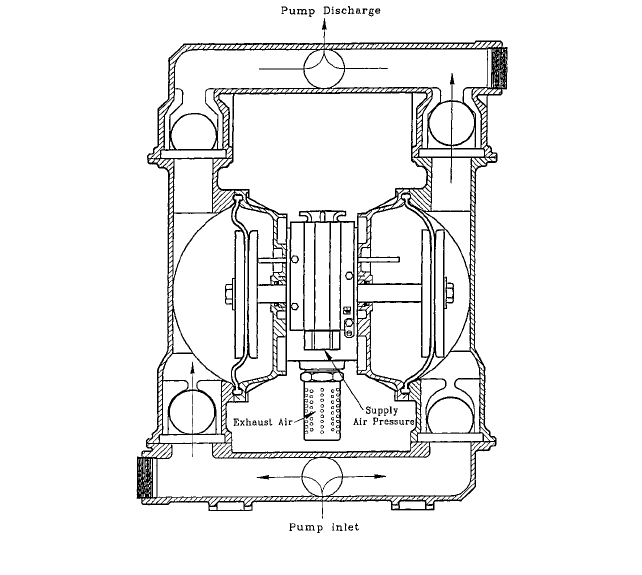
3.6 DIAPHRAGM PUMPS 3.95
FIGURE 12 Cross-section of an air-operated double-diaphragm pump with ball check valves (Ingersoll-Rand
Fluid Products)
operate in any orientation. Since many diaphragm pumps are used to pump abrasive slur-
ries, the valves usually have elastomeric faces or are elastomeric balls. Large ball check
valves may have metal cores covered by a thick wall of synthetic rubber. They may also be
made of solid rubber, a thermoplastic elastomer, or Teflon
®
.
Diaphragms are customarily made of fabric-reinforced synthetic rubber, thermoplastic
elastomers, or PTFE. Diaphragm materials include most of the synthetic rubbers: neo-
prene, Buna N, EPR, Viton
®
, thermoplastic elastomers such as Hytrel
®
and Santoprene
®
as
well as Teflon
®
. Many combinations of pump and diaphragm materials can cover a wide
range of pumped products. For some solvents and aggressive acids or alkalis, Teflon
®
diaphragms can be used either directly or as an overlay on the conventional diaphragm.
The diaphragms in air-operated, double-diaphragm pumps are essentially balanced
and act simply as membranes separating the compressed air from the product being
pumped. The only unbalance occurs during the suction stroke of one diaphragm while it
is being pulled by the shaft-connected other diaphragm. When the suction lift is minimal,
the unbalance may be negligible.
Pump case materials include cast iron, aluminum, stainless steel, Carpenter 20,
Hastelloy C, and plastics reinforced with glass or metal fibers.
APPLICATIONS OF AIR-OPERATED DIAPHRAGM PUMPS___________________
General
Diaphragm pumps are ideally suited for handling abrasive slurries because 1)
the liquid velocity through the check valves and pumping chambers does not exceed the
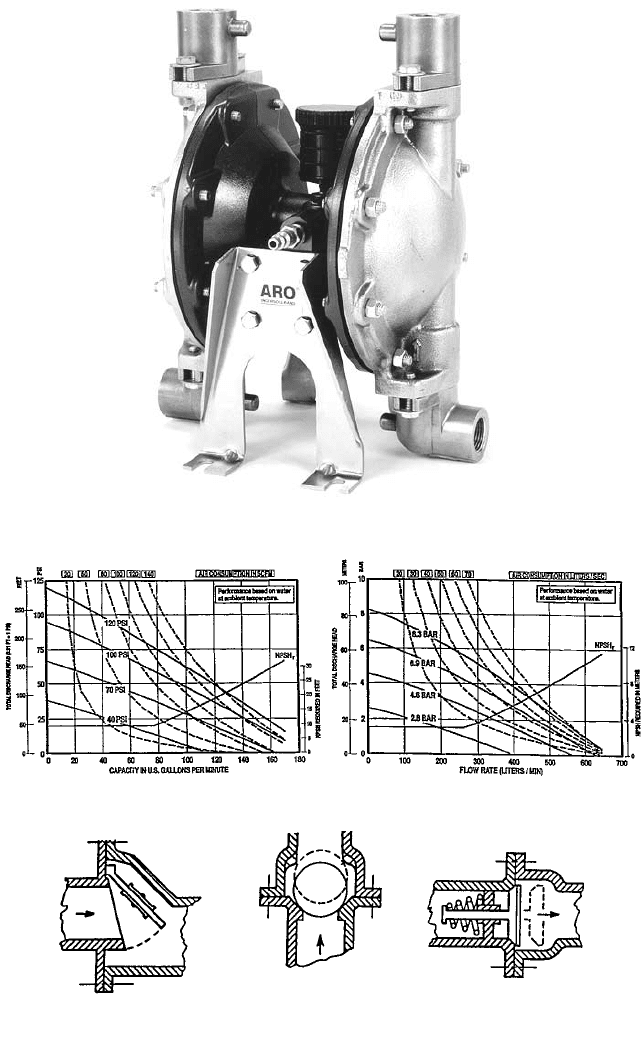
3.96 CHAPTER THREE
FIGURE 13 ARO air-operated double-diaphragm pump with ball check values (Ingersoll-Rand Fluid Products)
FIGURE 14 Performance curve for a 2-in air-operated double-diaphragm pump
FIGURE 15 Three basic types of check valves
FLAP BALL POPPET
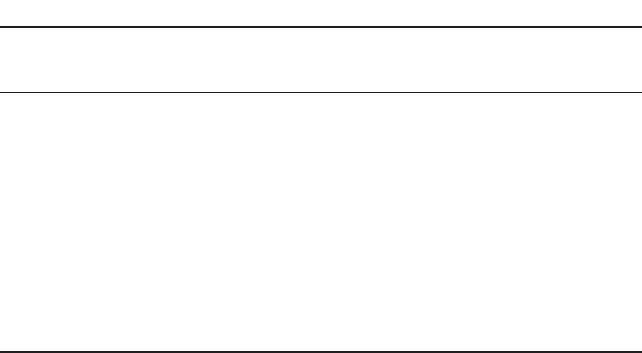
3.6 DIAPHRAGM PUMPS 3.97
TABLE 1 Control of diaphragm pumps
Electro-
Magnetically Mechanically Hydraulically Air-
Feature Driven Driven Driven Operated
Can run dry: Yes Yes Yes Yes
Self-priming: Yes Yes Yes Yes
Discharge Yes No Yes Yes
can be
shutoff
without
damage:
Relief valve No Yes Integral to No
required: pump
Flow Motor speed or Motor speed or Motor speed or Motor
controlled stroke-length stroke-length stroke-length speed or
by: adjustment adjustment adjustment discharge
valve
pipeline velocity and 2) the scouring and abrasions from the slurry are minimal. Because
no close-fit sliding or rubbing parts exist and velocities are low, these pumps can be used
for liquids with viscosities up to 50,000 SSU (11,000 cSt). Because the turbulence and mix-
ing are minimal, they are ideally suited for shear-sensitive materials, such as latex.
Pumping Dry Powders Since diaphragm pumps can pump air as well as liquids, they
are used successfully to pump dry powders. The air acts as a fluid medium for the pow-
ders in suspension, and the pump moves the air containing the suspended powder. Some-
times it is necessary to inject air into the powder to lower the apparent specific gravity
and to get the powder into suspension.
Pump Controls An air pressure regulator in the compressed air supply line can con-
trol the pumping pressure. An air line valve can control the pumping rate. Thus, the pres-
sure and capacity are easily controlled. Although air-operated diaphragm pumps are
displacement pumps, they are not positive ones. The maximum pumping pressure cannot
exceed the pressure of the compressed air powering the pumps. Table 1 describes the con-
trol of diaphragm pumps with the features inherent with each drive type.
Liquids Handled and Applications A variety of liquids can be handled by AODPs, yet
the compatibility of pump case materials, valve materials, and diaphragms is the basic
application limitation. Liquids and slurries handled by diaphragm pumps include ceramic
slurry, paint, cement grout, chemicals, glue, resins, petroleum products, driller’s mud, mill
scale, ore concentrates, printer’s ink, sewage, filter aids, latex, waste oils, wood preserva-
tives, core washes, asphaltic coatings, bilge waste, radioactive waste, lapping compounds,
porcelain frit, mine tailings, volatile solvents, coolants with metal fines, varnish, acids,
coatings, soapstone slurries, explosives, lime slurries, yeast, chocolate, and wine. Typical
applications of AODPs include tank and container loading and unloading, fluid filtration,
spray painting, adhesive application, process mixing and batching, cutting oil, machine
coolant, lubrication, sump pumping, dewatering, and waste water treatment.
LIMITATIONS AND ADVANTAGES OF AIR-OPERATED DIAPHRAGM PUMPS____
This section outlines the pros and cons of AODPS. Table 1 also details the controls of the
different types of pumps. The limitations of AODPs are as follows:
3.98 CHAPTER THREE
• AODPs are not practical for pumping rates above about 300 gpm (1150 //m).
• AODPs are not manufactured for operating air pressures above 125 lb/in
2
gauge (8.6
bar). However, some versions are available that increase the pressure ratio by 2:1 or 3:1.
• Ice formation in air motors can occur (basic to the physics of operation), but the effect
can be minimized by proper application and design.
• Diaphragms have a finite life. Fluids with abrasives and higher process temperatures
can limit a diaphragm’s life, but many material choices are available, including Teflon
®
‚
and several thermoplastic elastomers.
An AODP’s advantages are as follows:
• They are self-priming from a dry start.
• The pumps have an infinitely variable flow rate and pressure-within-pressure and
capacity ranges.
• AODPs have no dynamic seals or packing.
• They can run dry indefinitely.
• The discharge can be throttled to zero flow indefinitely.
• No air is used when the AODP is deadheaded. Electrically driven pumps will consume
a significant portion of the rated power when no demand flow exists.
• AODPs are suited for use in hazardous environments (no electric power required).
• Power is used in proportion to the pumping rate.
• They can be used in confined areas without heat buildup.
• AODPs can pump abrasive slurries and solids in suspension.
• The pumps can handle viscous liquids up to 50,000 SSU (11,000 cSt).
• A minimal degradation of the viscosity of shear-sensitive materials occurs.
• They can pump dry powders in air suspension.
• No close-fit, sliding, or rotating parts come in contact with liquid.
• No bypass is required as in other displacement pumps.
• When properly maintained, there is zero leakage.
• They are simple to maintain and to repair.
• There is no bedplate and no coupling to align.
• AODPs can be used in handling aggressive chemical solutions.
• They can handle a wider range of materials than any other type of pump.

J. R. BRENNAN
G. J. CZARNECKI
J. K. LIPPINCOTT
A. J. PRANG
3.99
SECTION 3.7
SCREW PUMPS
Screw pumps are a special type of rotary positive displacement pump in which the flow
through the pumping elements is truly axial. The liquid is carried between screw threads
on one or more rotors and is displaced axially as the screws rotate and mesh (see Figure
1). In all other rotary pumps, the liquid is forced to travel circumferentially, thus giving the
screw pump with its unique axial flow pattern and low internal velocities a number of
advantages in many applications where liquid agitation or churning is objectionable.
The applications of screw pumps cover a diversified range of markets including navy,
marine, and utilities fuel oil services; marine cargo; industrial oil burners; lubricating oil
services; chemical processes; petroleum and crude oil industries; power hydraulics for
navy and machine tools; and many others. The screw pump can handle liquids in a range
of viscosities, from molasses to gasoline, as well as synthetic liquids in a pressure range
from 50 to 5000 lb/in
2
(3.5 to 350 bar) and flows up to 8000 gal/min (1820 m
3
/h).
Because of the relatively low inertia of their rotating parts, screw pumps are capable
of operating at higher speeds than other rotary or reciprocating pumps of comparable dis-
placement. Some turbine-attached lubricating oil pumps operate at 10,000 rpm and even
higher. Screw pumps, like other rotary positive displacement pumps, are self-priming and
have a delivery flow characteristic, which is essentially independent of pressure, provided
there is sufficient viscosity in the liquid being pumped.
Screw pumps are generally classified into single- or multiple-rotor types. The latter is
further divided into timed and untimed categories.
The single-screw or progressive cavity pump (see Figure 2) has a rotor thread that is
eccentric to the axis of rotation and meshes with internal threads of the stator (rotor hous-
ing or body). Alternatively, the stator is made to wobble along the pump centerline.
Multiple-screw pumps are available in a variety of configurations and designs. All
employ one driven rotor in a mesh and one or more sealing rotors. Several manufacturers
have two basic configurations available: single-end (in Figure 3) and double-end (in Figure
4) construction, of which the latter is the better known.
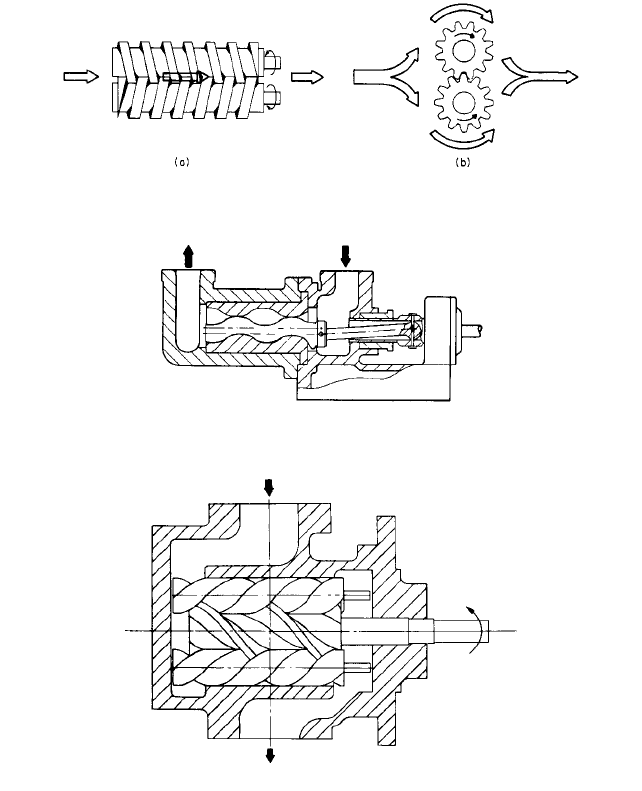
3.100 CHAPTER THREE
FIGURE 3 Multiple-screw single-end arrangement.
FIGURE 1 Diagrams of screw and gear elements, showing (a) axial and (b) circumferential flow.
FIGURE 2 The single-screw or progressive cavity pump
As with every pump type, certain advantages and disadvantages can be found in a
screw pump design. These should be recognized when selecting the best pump for a par-
ticular application. The advantages of a screw pump design are as follows:
• A wide range of flows and pressures
• A wide range of liquids and viscosities
• High speed capability, allowing the freedom of driver selection
• Low internal velocities
• Self-priming, with good suction characteristics
• A high tolerance for entrained air and other gases
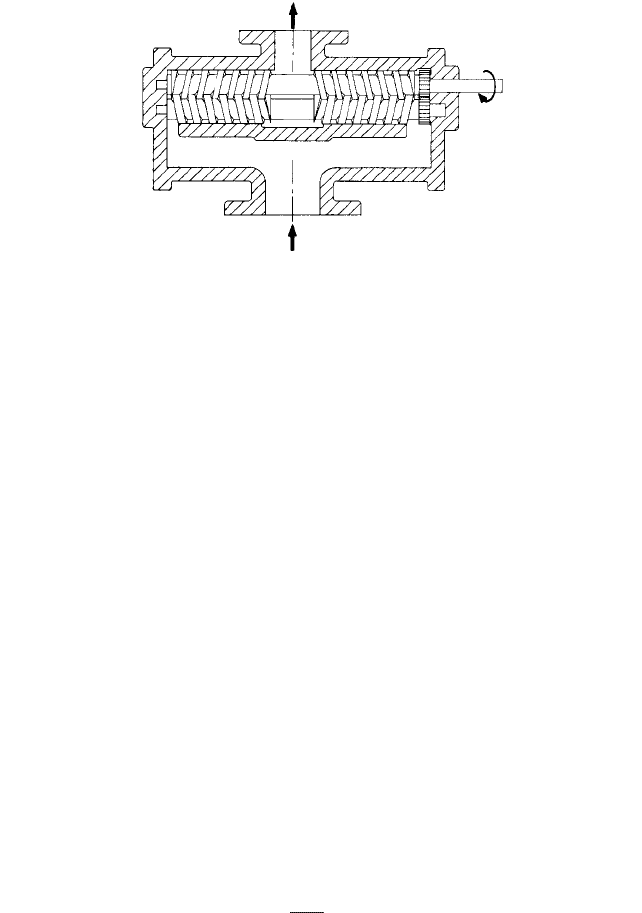
3.7 SCREW PUMPS 3.101
FIGURE 4 Mutliple-screw double-end arrangement.
• Low velocities for minimum churning or foaming
• Low mechanical vibration, pulsation-free flow, and quiet operation
• A rugged, compact design that is easy to install and maintain
• High tolerance to contamination in comparison with other rotary pumps
The disadvantages are as follows:
• A relatively high cost because of close tolerances and running clearances
• Performance characteristics sensitive to viscosity changes
• High pressure capability requires long pumping elements
THEORY ____________________________________________________________
In screw pumps, it is the intermeshing of the threads on the rotors and the close fit of the
surrounding housing that creates one or more sets of moving seals in a series between the
pump inlet and outlet. These sets of seals or locks, as they are sometimes referred to, act
as a labyrinth and provide the screw pump with its positive pressure capability. The suc-
cessive sets of seals form fully enclosed cavities (see Figure 5) that move continuously from
inlet to outlet. These cavities trap liquid at the inlet and carry it along to the outlet, pro-
viding a smooth flow.
Delivery Because the screw pump is a positive displacement device, it will deliver a def-
inite quantity of liquid with every revolution of the rotors. This delivery can be defined in
terms of displacement volume V
D
, which is the theoretical volume displaced per revolu-
tion of the rotors and is dependent only upon the physical dimensions of the rotors. It is
generally measured in cubic inches (cubic millimeters) per revolution. This delivery can
also be defined in terms of theoretical capacity or flow rate Q
t
measured in U.S. gallons
per minute (cubic meters per hour), which is a function of displacement and speed N:
In USC units:
In SI units:
If no internal clearances existed, the pump’s actual delivered or net flow rate Q would
equal the theoretical flow rate. Clearances, however, do exist with the result that when-
ever a pressure differential occurs, there will always be internal leakage from outlet to
inlet. This leakage, commonly called slip S, varies depending upon the pump type or
Q
t
6 10
8
V
D
N
Q
t
V
D
N
231
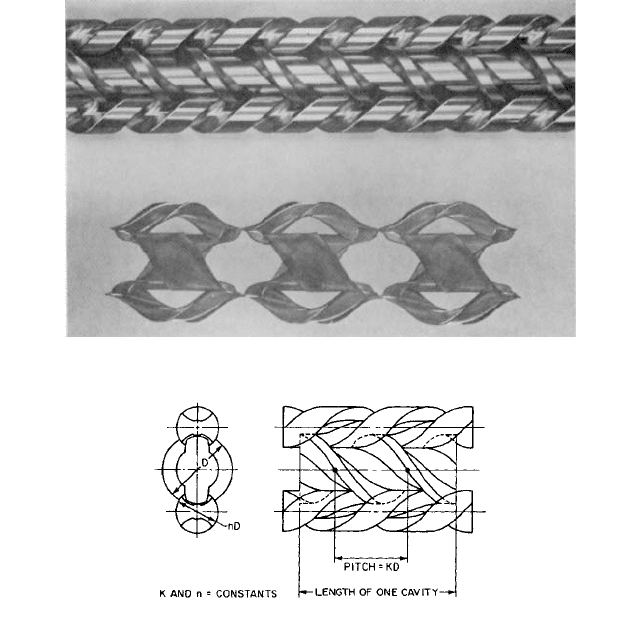
3.102 CHAPTER THREE
FIGURE 6 Screw-thread proportions, showing lead, diameters, and cavity length.
FIGURE 5 Axially moving seals and cavities. Alternate cavities filled with oil shown below. (Imo Pump)
model, the amount of clearance, the liquid viscosity at the pumping conditions, and the dif-
ferential pressure. For any given set of these conditions, the slip for all practical purposes
is unaffected by speed. The delivered flow rate or net flow rate therefore is the theoretical
flow rate less the slip: Q Q
t
S. If the differential pressure is almost zero, the slip may
be neglected and Q Q
t.
The theoretical flow rate of any pump can readily be calculated if all essential dimen-
sions are known. For any particular thread configuration, assuming geometric similarity,
the size of each cavity mentioned earlier is proportional to its length and cross-sectional
area. The thread pitch measured in terms of the same nominal diameter, which is used in
calculating the cross-sectional area (see Figure 6), defines the length. Therefore, the vol-
ume of each cavity is proportional to the cube of this nominal diameter, and the pump’s
theoretical flow rate is also proportional to the cube of this nominal diameter and the
speed of rotation N (rpm):
or, bringing the pitch into evidence,
From Figure 6, where pitch = KD, it follows that k = k
1
K.
Q
t
k
1
pitch D
2
N.
Q
t
kD
3
N
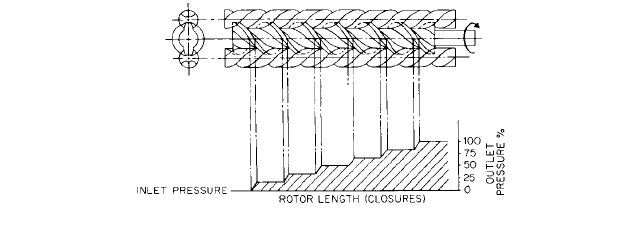
3.7 SCREW PUMPS 3.103
FIGURE 7 Pressure gradient along a screw set.
Thus, for a given geometry, it can be seen that a relatively small increase in pump size
can provide a large increase in flow rate.
Slip can also be calculated,
1,2
but usually it depends upon empirical values developed
by extensive testing.These test data are the basis of the design parameters used by every
pump manufacturer. Slip generally varies approximately as the square of the nominal
diameter. The net flow rate therefore is
Pressure Capability As mentioned earlier, screw pumps can be applied over a wide
range of pressures, up to 5000 lb/in
2
(345 bar), provided the proper design is selected.
Internal leakage must be restricted for high-pressure applications. Close-running clear-
ances and high accuracy of the conjugate rotor threads are requirements. In addition, an
increased number of moving seals between the inlet and outlet are employed, as in clas-
sic labyrinth-seal theory. The additional moving seals are obtained by a significant
increase in the length of the pumping elements for a given size of rotor and pitch. Here
the minimum pump length is sacrificed in order to gain pressure capability.
The internal leakage in the pumping elements resulting from the differential pressure
between the outlet and inlet causes a pressure gradient across the moving cavities. The
gradient is approximately linear (see Figure 7) when measured at any instant. Actually,
the pressure in each moving cavity builds up gradually and uniformly from inlet to outlet
pressure as the cavities move toward the outlet. In effect, the pressure capability of a
screw pump is limited by the allowable pressure rise across any one set of moving seals.
This pressure rise is sometimes referred to as pressure per closure or pressure per lock and
generally is of the order of 125 to 150 lb/in
2
(8.6 10 10.3 bar) with normal running clear-
ances, but it can go as high as 500 lb/in
2
(35 bar) when minimum clearances are employed.
Design Concepts The pressure gradient in the pump elements of all the types of screw
pumps produces various hydraulic reaction forces. The mechanical and hydraulic tech-
niques employed for absorbing these reaction forces are among the fundamental differ-
ences in the types of screw pumps produced by various manufacturers. Another
fundamental difference lies in the method of engaging, or meshing, the rotors and main-
taining the running clearances between them. Two basic design approaches are used:
• The timed rotors approach relies upon an external means for phasing the mesh of the
threads and for supporting the forces acting on the rotors. In this concept, theoretically,
the threads do not come into contact with each other or with the housing bores in which
they rotate (refer to Figure 4).
• The untimed rotors approach relies on the precision and accuracy of the screw forms
for the proper mesh and transmission of rotation. They utilize the housing bores as
journal bearings supporting the pumping reactions along the entire length of the rotors
(refer to Figure 3).
Q
t
kD
3
N S
